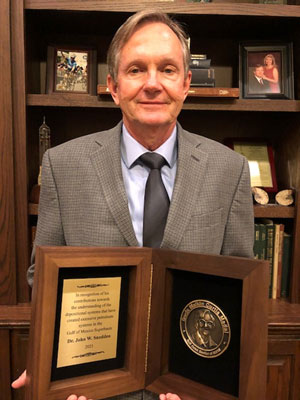Announcements:
39th Annual GCSSEPM Foundation Perkins-Rosen Research Conference
The 39th annual Perkins-Rosen Research Conference celebrates nearly three decades of progress in understanding deepwater sedimentary systems. The conferences in the 1990s – including the 1994 GCSSEPM Perkins-Rosen Research Conference – emphasized submarine fans, reservoir presence, depositional architecture and outcrop analogs.
The focus of the 2023 conference will include what has been learned from the Gulf of Mexico to the Atlantic margins, to frontier basins as well as in laboratory studies and outcrops worldwide. We want to show the progress that has been made in the following areas:
- the range and variability in new deepwater play types globally,
- source-to-sink linkage of terrestrial, to deltaic, to deepwater systems,
- mixed deepwater sedimentary systems that incorporate a wide range of oceanic and seafloor processes (turbidite, contourite, hemipelagite/pelagite and mass-transport deposit inputs, etc.),
- physical modeling approaches as well as the advances in technology and process modeling in understanding the distribution of petroleum elements, including the use of artificial intelligence and digital workflows,
- deepwater mudrocks and more specifically their role as seals and source rock intervals as well as natural seafloor seeps,
- the influence of mobile substrates, including evaporites and mud, on deepwater sedimentary architecture above and below the mobile substrate.
Advancements in the understanding of deepwater sedimentary systems based on direct measurements of sedimentary basins including cores and outcrops, seismic and borehole imaging, physical and numerical modeling, and fieldwork or any new aspect from around the world are welcome.
Most importantly, examples of diverse deepwater exploration plays that have worked (or failed) as well as yet-to-be-tested plays are welcome. This conference will attempt to review the number of deepwater-related challenges that are yet to be solved, therefore providing a roadmap of where deepwater may go over the next three decades.
John Snedden
Receives the Doris Malkin Curtis Medal

John Snedden received the GCSSEPM’s highest honor, The Doris Malkin Curtis Medal, at the GeoGulf meeting in Austin for his longstanding contributions to Gulf Coast geology. The citation by current GCSSEPM President Michael Sweet read in part, “GCSSEPM is recognizing John for his contributions to the understanding of the depositional systems and extensive petroleum systems in the Gulf of Mexico Basin. John is the Director of the Gulf Basin Depositional Synthesis Project (GBDS) in the Institute for Geophysics at The University of Texas at Austin. In 2019, John and GBDS-founder Bill Galloway published “The Gulf of Mexico Sedimentary Basin”—a landmark volume that encapsulated decades of work by John, Bill, their students, and their colleagues at UT Austin.”
The rest of the citation can be found here
Sponsoring the GCSSEPM
If you wish to sponsor the GCSSEPM, please visit our detailed Sponsorship page.
